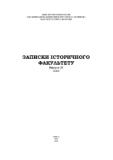ПРО МОЖЛИВУ РОЛЬ МІГРАЦІЙНИХ ПРОЦЕСІВ У ФОРМУВАННІ АЗОВО-ДНІПРОВСЬКОЇ КУЛЬТУРИ
ON THE POSSIBLE ROLE OF MIGRATION PROCESS IN SHAPING THE AZOV-DNIEPER CULTURE
Author(s): Olga V. DemchenkoSubject(s): Archaeology, Cultural history, Migration Studies
Published by: Видавництво «Одеський національний університет І. І. Мечникова»
Keywords: migration; comb ornamentation; Neolithic; Azov-Dnieper culture; Azov Sea region; Northern Pontic region;
Summary/Abstract: The emergence of new techniques and technologies has always been one of the main issue of discussion in archaeology. Especially in the case of innovations introduced from outside rather than development of the local tradition. Was it the result of migrations or was it just the transmission of «fashion trends»? Were environmental changes the cause of their spread, and if so, which exactly were? In 2019, the author continued excavations the single-layer site Chapayevka in the Azov Sea region. The results of excavations confirmed the emergence of a completely different population in the region in the early 6th Mill. BC, which is radically different from the local Late Mesolithic and Early Neolithic societies. Previously, this group has never been considered separately. In the literature, it is customary to refer them to the earliest period of the Azov-Dnieper culture. Nevertheless, the uniqueness of the materials allowed us to assume the presence of migration movements at the beginning of the 6th Mill BC. It was really newcomer population who left the Chapaevka type sites and later, as a result of mixing (or maybe diffusion) with the local residents, the Azov-Dnieper culture in its classical form was formed. According to radiocarbon dating, in the Northern Pontic Region comb-ornamented pottery appeared in quantities at the beginning of the 6th mill. BC. Around the same time, impresso ware appeared in the European continent (Thessaly, Adriatic, Southeast Balkans etc.). The most likely cause event triggered the spread of early farmers, by different routes out of West Asia and the Near East was climate changes of aridity of 8200 cal BP. Perhaps the population could also move eastward to the Northern Pontic Region (water and/or landway). We will try to prove the fact of the migration process but not only spread of the fashion trend in to Ukrainian steppe region in the very beginning of the 6th millennium BC. on example of Chapaevka type sites. After reviewing the numerous literature about ancient migrations and based on our regional specifics, we created a fairly simple scheme that combines various criteria. As a result, we have four thematic blocks of our evidence base. The main idea of the article is considering the causes and possible penetration paths of newcomers in to the region. Comparison of the materials identifies the weather it was a real migration of an identical population but not only borrowing of "fashion trend". This research will allow to revise the set of contemporary outdated explanations of the Neolithisation of the Northern Pontic region. The results will enable to explain the migration routes and the ways of spreading Neolithic innovations.
Journal: Записки історичного факультету
- Issue Year: 2020
- Issue No: 31
- Page Range: 5-16
- Page Count: 12
- Language: Ukrainian

